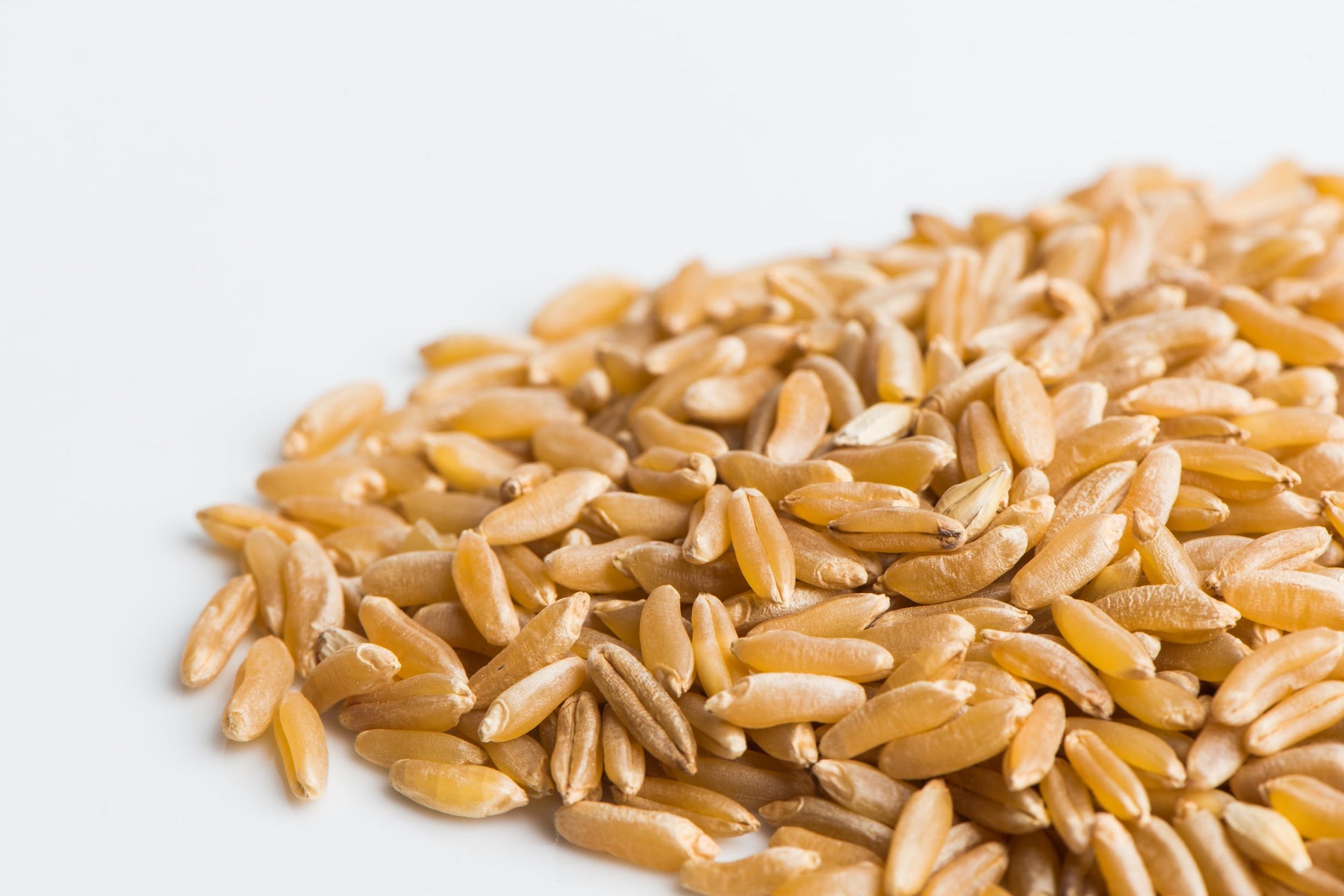Kamut®
Kamut®
Couldn't load pickup availability
Kamut® is an ancient grain believed to have been first used in the fertile crescent. Now patented in the US!
- Days to Sprout: Sprout- 2-3; Microgreen- 10-12
- Soak Time: 6 hours
- Storage: Our seeds should sprout well for a year after you purchase them, if stored in a cool dry place. If you'd like to extend the germination life of your seeds, store them in the fridge. If you store your seeds in the freezer, they'll last even longer!
Sprouting Directions
Soak: Put approximately 1/4 cup seed in a wide mouth jar with a sprouting lid. Add water, swirl, and drain. Refill jar with water and soak 6-12 hours. Drain well and invert jar at an angle on a sprouting rack, or in a bowl or drain rack.
Rinse: Twice a day, refill jar with cold water, swirl, and drain.
Enjoy! Ready to eat in (2-3) days. Refrigerate to store.
Helpful tip:
- If you notice hard seed after soaking, next time soak longer or use hot water 125F/50C let water cool down while soaking for 4-12hrs. Experiment with what works best.
Growing Directions
Growing Directions
Grow Microgreens!
Soil Method
• 10” x 20” gardening trays (1-inch-tall preferred), 1 with
holes + 1 without. Smaller microgreen trays also work well.
• Good quality organic starting soil mix
• Parchment paper or unbleached paper towel,
• Dome lids (clear or black) or plastic sheet
• Organic seed
• Mister bottle, cup measures, garden spray nozzle (optional)
• Scissors or sharp knife
1. Soak the Seed
Larger seed such as sunflower, buckwheat, microgreen salad mix, wheat and peas should be washed then soaked in water for 6 – 12 hours prior to seeding. Drain, rinse and drain the seed after soaking.
2. Prepare Soil
Add water to top of the bag (or each tray) 12 hours ahead of use until almost fully hydrated. Rehydrate the bag as necessary. If you were to put the soil in your hand and squeeze it, you should not be able to get much more than a drop of water out of it for the perfect moisture content. If you want to mist the seed after putting it on the soil, reduce the water hydration of the bagged soil a bit.
TIP: To check for overwatering, tip the tray to one end. Water should not pool enough to drip out of the tray.
3. Fill Trays with Soil
Use a tray with holes. Fill with 3/4-1.5” of soil. The closer to the top of the tray the better aid to air circulation. Use a block or your hand to smooth and flatten the soil without compacting it. The back of a tablespoon or spatula smooths out the valleys. You can wait to put the tray without holes under until after unstacking/uncovering or add it to the bottom now.
TIP: Place a layer or two of paper towel on the bottom of the tray before adding soil for easier cleanup.
4. Sow the Seed
Spread the soaked seed evenly over the soil in the tray. The seeding density depends on the stage at which you’re planning to harvest. You should have one layer of seeds, side by side and mostly not overlapping. Spread out any clumps with a spoon or your hands. Sow slightly less seed for 2-3 week microgreens.
5. Cover the Seed
Doing away with soil as a seed cover decreases the work and time it takes to grow the greens. If stacking the trays on top of each other, use a cover directly on the seed like parchment paper, a plastic sheet or wet unbleached paper towel layer. When not stacking trays, the seed will need protection from drying out by using a dome/lid. Use a clear dome or an inverted 10 x 20” tray without holes. For smaller trays, use several layers of unbleached paper towels folded onto itself with or without a plastic sheet covering the top.
TIP: Most microgreens will grow taller when you keep the light out at the beginning, but this may make the stem weaker. Most seeds germinate in the light no problem.
6. Stack Trays
Stacking helps to quickly force the roots into the soil, provides darkness, promotes even germination/growth. Stack 2-5 filled trays on top of each other with an empty tray on the top of the stack with a weight in it. Check at least once a day to see if the trays need water. Stack for 3-5 days. Sunflowers stay stacked the longest -5 days. Put no holes trays under the soil filled holed trays.
7. Expose to Indirect Sunlight, Florescent/LED or Grow Lights.
After 2-5 days, the microgreens should be ready for light. If the microgreens begin to get quite tall and leggy, this is an indication that they may need a bit more light.
8. Water the Growing Microgreens
Check the seed once or twice daily and water as needed. The soil should be moist, not wet. Once trays are unstacked, add water from below into the no holes tray as necessary.
9. Harvest!
Sunflowers, buckwheat, and wheat grass is usually harvested around 9 to 10 days with scissors or a sharp knife. Make sure microgreens are not damp before storing. If needed, you may use a small fan or salad spinner to dry the microgreens before storing in a sealed container in the fridge.
Instead of harvesting all at once, you can start to harvest microgreens as soon as the first two leaves are spread out. Take only what you need for your meal and allow the rest to keep growing or put the tray in the fridge loosely covered and a plastic bag or dome to harvest another day. Water as necessary.
10. Enjoy!
Microgreens make everything better, so have fun with them and add them to your favourite dishes!
Helpful tips:
• To moisten your bag of soil, add water ahead until almost fully hydrated.
• The roots grow under the soil so it works well to water from below if the tray has holes in it, or open the side of the tray and pour water beside the soil when using flexible plastic trays. Otherwise misting or watering from the top works well too.
• Good cleaning practices each growing cycle: Remove debris from trays. Apply soap to a brush and clean all surfaces with suds and firm pressure. Rinse. Sanitize your trays, equipment, tools and surfaces
Best Growing Methods
Best Growing Methods
Did You Know
Did You Know
Nutritional Information
Nutritional Information

Let's Grow Together
We care deeply about people and the planet. As a second-generation family business, we go the extra mile to make sure you have a great growing experience. That means sourcing top-quality organic seeds—many from small farms here in Saskatchewan—and testing every lot in-house to ensure strong germination, cleanliness, and vibrant results. We're here to help you grow with confidence, every step of the way.
the seeds I planted a few days ago are sprouting and growing like crazy. we have pet herbivores so I grow fodder for them all winter.
Graines de très bonne qualité, germinations super, très satisfaite de vos produits merci, ma conure les adore!
Great , our parrots enjoy these germinated grains every day!
Use this item to create Rejuvelac juice and it tastes great. Easy to do and enjoy.
Nice, clean, unbroken. Sprouted beautifully.. some are eaten by my parrot, some end up in salads, some are dried and milled for flour.

